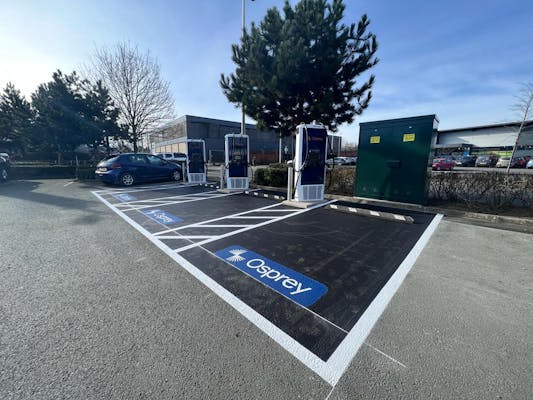Adopting accessible EV charging standards.
Osprey Charging Network has adopted the new BSI standard (PAS1899) to provide accessible electric vehicle charging for drivers.
As one of the UK’s largest and leading networks of electric vehicle (EV) charging stations, Osprey understands the importance of accessibility and we are committed to ensuring that all drivers feel confident and comfortable when visiting our sites.
In 2022 we closely followed the creation of draft BSI standards for accessible charging, sponsored by the UK charity Motability, and actively sought feedback from our customers with mobility requirements about their experience. We also became the first charge point operator to subscribe to the independent inspection body ChargeSafe and were vocal in our public support of the Standards.
This allowed gave us an in-depth understanding of the crucial elements in the design of all public charging sites, including: space, kerbs, screen and handle height, payment ease, cables and the general overall usability of a charger.
Re-designing our sites.

As a result, we re-designed the set-up of both our “compact” and “hub” sites in line with anticipated PAS 1899 criteria:
- Putting the chargers in-bay for access without kerbs
- Including more space and cross-hatched protected areas
- Installing more accessible hardware (Tritium 75kW, Kempower 150kW – both with weight-managed cables and low screens, all with contactless card payment as standard)
- When returning to older, smaller sites to add a charge point, we re-configure the bay layout to improve accessibility and install better hardware.
Ahead of the new EV charging standards, we launched the UK’s first accessibly designed rapid charging hub at the Paisley Pear in Brackley. This flagship hub put into practice these elements to deliver improved accessibility and improved experience in all areas for all drivers.
The Paisley Pear hub earned the highest ChargeSafe rating for Accessibility on the UK network and showcased what should be the standard for all charging networks going forward. You can read and watch more about the site here.
A few months later in 2022, the PAS 1899 standard was published. Since then, we have taken a range of specific measures to ensure compliance with the specific accessibility requirements:
- No longer using hoop bollards at our 2 charger in-bay sites. When existing sites are upgraded or if bollards are damaged we’ll replace them with post bollards and remove the hoops.
- Adding physical labels for each of the connector types on the hardware that does not have this already.
- Adding security cameras and lighting where possible with landlord consent to improve the safety of our sites, especially at night.
- On sites where the space allows we’re installing extra long bays that can serve both WAVs and those customers who have trailers or caravans.
- Planning to install more canopies at more hub sites to offer weather protection for customers.
- Persuading partner landlords to build all sites with at least some accessible bays.
Our ideal scenario is to build all new sites with all bays fully accessible and PAS 1899 compliant, however, this is not always possible due to a lack of landlord consent for the extra space required. In these cases, we aim to get an agreement for a minimum of two bays to meet the standards on accessible charging.
Evolving our legacy hubs

We are also constantly reviewing and sometimes evolving our site design within the standards, especially in response to feedback from customers with access requirements, to make sure that our charging stations are genuinely accessible to everyone.
At Osprey, we are not just focused on new sites. We are auditing our estate of older sites for compliance with PAS 1899 and have an upgrade program underway to make our older sites more accessible, with over 25 sites already upgraded this year by installing additional and sometimes higher-power chargers and/or redesigning the bay layout. This program will continue throughout 2023 to improve accessibility and charging experience wherever possible.
Osprey continues to be actively engaged with the PAS 1899 standard, for example, our in-house expert attended Parliament to discuss its launch and the forthcoming Design Guidance for Accessible EV Charging, produced by Designability.
At Osprey, we believe that accessibility should be a priority for all businesses, and we want to set an example in the electric vehicle charging industry. Accessibility is not just about meeting standards but also about making sure that everyone can truly use our charging stations worry-free. We will continue to work hard to ensure that all drivers can enjoy the benefits of driving electric.
More insights.
Keep up with the latest insights from Osprey Charging.





